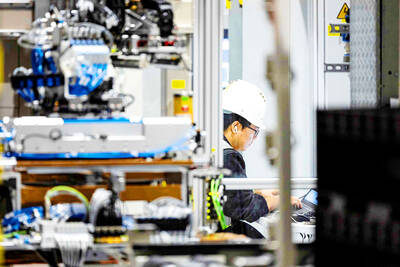Online food delivery platforms have seen explosive growth in Taiwan this year, helped by business opportunities related to the COVID-19 pandemic, company executives said at a digital commerce conference in Taipei yesterday.
When the threat of COVID-19 kept people from going out to eat, more people experimented with ordering food deliveries online, Foodpanda Taiwan Co Ltd (富胖達) operations director Nick Yu (余岳勳) said.
Foodpanda started operations in Taiwan in 2012.

Photo: CNA
“We experienced 5,000 percent growth in the past 24 months,” Yu said. “That’s more than the previous six years combined.”
In 2016, only 2 percent of food orders were delivered in Taiwan, but that increased to 10 percent four years later, Yu said, adding that the market is far from saturated.
“If you look at China, about 20 percent of the food and beverage market is via delivery,” Yu said. “Taiwan still has a long way to go.”
Yu credits the strategy of localization as key to Foodpanda’s success in Taiwan.
“Sixty-seven percent of our partner businesses are local heroes — independent restaurants and even night market stalls,” Yu said. “Partnering with Foodpanda is the easiest way to gain a platform.”
Becoming a Foodpanda driver also became a good way for those furloughed in the wake of the pandemic to get work quickly.
“You can join us anytime as a delivery driver — and work whenever and however much you want,” Yu said.
Foodpanda aims to get deliveries to its customers in 30 minutes, part of a trend that Yu calls “quick commerce” or “q commerce.”
“If delivery is within an hour, you don’t need to stock up,” Yu said. “Pandamart will be a ‘shadow shop’ with 300 items that can be delivered in 30 minutes.”
An example of a “shadow kitchen,” Just Kitchen CEO Jason Chen (陳星豪) said that his business quickly took off this year.
“We only started this year and have seen rapid growth since the beginning,” Chen said. “Since July, we have had a positive cash flow.”
The penetration rate for food delivery in Taiwan was only 35 percent in March, but up to 70 percent by July, Chen said.
“It’s an explosively growing industry, but the pandemic pushed it over the top,” he added.
Just Kitchen’s innovation was to take the existing cloud kitchen concept and turn it into a hub-and-spoke system, with semi-finished food being distributed from one central kitchen along five spokes to all of Taipei, Chen added.
“That way, instead of competing with restaurants in our vicinity, we put the food right where people need it,” Chen said.
JustKitchen uses big data technology to track and analyze information related to customer orders, habits, likes and dislikes, he said.
“The data decides everything, from where we put our spokes to how much chicken we have in stock,” Chen said, adding that supplies in the kitchen are meticulously tracked for food safety and to cut waste.
Chen said that he chose to start Just Kitchen in Taiwan because of a mature local food and beverage market, low overheads and operating costs, and a high population density.
“Taiwan is the kingdom of food lovers,” Chen said. “It’s a good place to prove our model and then take it everywhere else.”
Yu and Chen spoke yesterday at the Discover Advanced Trends in E-economy Summit, a forum on trends in digital commerce organized by the Taiwan External Trade Development Council (外貿協會).

CHIP RACE: Three years of overbroad export controls drove foreign competitors to pursue their own AI chips, and ‘cost US taxpayers billions of dollars,’ Nvidia said China has figured out the US strategy for allowing it to buy Nvidia Corp’s H200s and is rejecting the artificial intelligence (AI) chip in favor of domestically developed semiconductors, White House AI adviser David Sacks said, citing news reports. US President Donald Trump on Monday said that he would allow shipments of Nvidia’s H200 chips to China, part of an administration effort backed by Sacks to challenge Chinese tech champions such as Huawei Technologies Co (華為) by bringing US competition to their home market. On Friday, Sacks signaled that he was uncertain about whether that approach would work. “They’re rejecting our chips,” Sacks

NATIONAL SECURITY: Intel’s testing of ACM tools despite US government control ‘highlights egregious gaps in US technology protection policies,’ a former official said Chipmaker Intel Corp has tested chipmaking tools this year from a toolmaker with deep roots in China and two overseas units that were targeted by US sanctions, according to two sources with direct knowledge of the matter. Intel, which fended off calls for its CEO’s resignation from US President Donald Trump in August over his alleged ties to China, got the tools from ACM Research Inc, a Fremont, California-based producer of chipmaking equipment. Two of ACM’s units, based in Shanghai and South Korea, were among a number of firms barred last year from receiving US technology over claims they have

It is challenging to build infrastructure in much of Europe. Constrained budgets and polarized politics tend to undermine long-term projects, forcing officials to react to emergencies rather than plan for the future. Not in Austria. Today, the country is to officially open its Koralmbahn tunnel, the 5.9 billion euro (US$6.9 billion) centerpiece of a groundbreaking new railway that will eventually run from Poland’s Baltic coast to the Adriatic Sea, transforming travel within Austria and positioning the Alpine nation at the forefront of logistics in Europe. “It is Austria’s biggest socio-economic experiment in over a century,” said Eric Kirschner, an economist at Graz-based Joanneum

France is developing domestic production of electric vehicle (EV) batteries with an eye on industrial independence, but Asian experts are proving key in launching operations. In the Verkor factory outside the northern city of Dunkirk, which was inaugurated on Thursday, foreign specialists, notably from South Korea and Malaysia, are training the local staff. Verkor is the third battery gigafactory to open in northern France in a region that has become known as “Battery Valley.” At the Automotive Energy Supply Corp (AESC) factory near the city of Douai, where production has been under way for several months, Chinese engineers and technicians supervise French recruits. “They